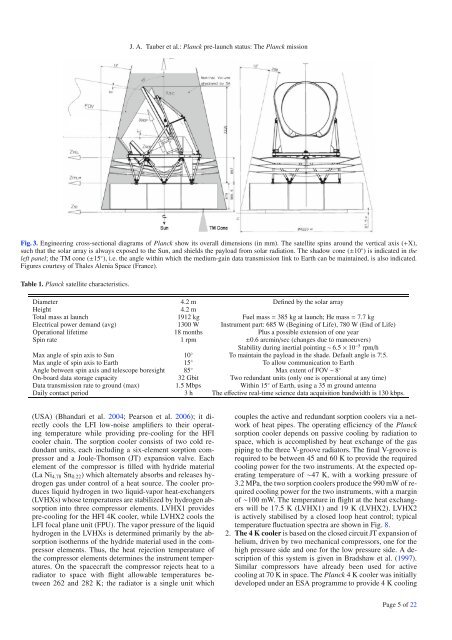Planck Pre-Launch Status Papers - APC - Université Paris Diderot ...
Planck Pre-Launch Status Papers - APC - Université Paris Diderot ...
Planck Pre-Launch Status Papers - APC - Université Paris Diderot ...
You also want an ePaper? Increase the reach of your titles
YUMPU automatically turns print PDFs into web optimized ePapers that Google loves.
J. A. Tauber et al.: <strong>Planck</strong> pre-launch status: The <strong>Planck</strong> missionFig. 3. Engineering cross-sectional diagrams of <strong>Planck</strong> show its overall dimensions (in mm). The satellite spins around the vertical axis (+X),such that the solar array is always exposed to the Sun, and shields the payload from solar radiation. The shadow cone (±10 ◦ )isindicatedintheleft panel; theTMcone(±15 ◦ ), i.e. the angle within which the medium-gain data transmission link to Earth can be maintained, is also indicated.Figures courtesy of Thales Alenia Space (France).Table 1. <strong>Planck</strong> satellite characteristics.Diameter 4.2 m Defined by the solar arrayHeight4.2 mTotal mass at launch 1912 kg Fuel mass = 385 kg at launch; He mass = 7.7 kgElectrical power demand (avg) 1300 W Instrument part: 685 W (Begining of Life), 780 W (End of Life)Operational lifetime 18 months Plus a possible extension of one yearSpin rate 1 rpm ±0.6 arcmin/sec (changes due to manoeuvers)Stability during inertial pointing ∼ 6.5 × 10 −5 rpm/hMax angle of spin axis to Sun 10 ◦ To maintain the payload in the shade. Default angle is 7. ◦ 5.Max angle of spin axis to Earth 15 ◦ To allow communication to EarthAngle between spin axis and telescope boresight 85 ◦ Max extent of FOV ∼ 8 ◦On-board data storage capacity 32 Gbit Two redundant units (only one is operational at any time)Data transmission rate to ground (max) 1.5 Mbps Within 15 ◦ of Earth, using a 35 m ground antennaDaily contact period 3 h The effective real-time science data acquisition bandwidth is 130 kbps.(USA) (Bhandari et al. 2004; Pearsonetal.2006); it directlycools the LFI low-noise amplifiers to their operatingtemperature while providing pre-cooling for the HFIcooler chain. The sorption cooler consists of two cold redundantunits, each including a six-element sorption compressorand a Joule-Thomson (JT) expansion valve. Eachelement of the compressor is filled with hydride material(La Ni 4.78 Sn 0.22 )whichalternatelyabsorbsandreleaseshydrogengas under control of a heat source. The cooler producesliquid hydrogen in two liquid-vapor heat-exchangers(LVHXs) whose temperatures are stabilized by hydrogen absorptioninto three compressor elements. LVHX1 providespre-cooling for the HFI 4K cooler, while LVHX2 cools theLFI focal plane unit (FPU). The vapor pressure of the liquidhydrogen in the LVHXs is determined primarily by the absorptionisotherms of the hydride material used in the compressorelements. Thus, the heat rejection temperature ofthe compressor elements determines the instrument temperatures.On the spacecraft the compressor rejects heat to aradiator to space with flight allowable temperatures between262 and 282 K; the radiator is a single unit whichcouples the active and redundant sorption coolers via a networkof heat pipes. The operating efficiency of the <strong>Planck</strong>sorption cooler depends on passive cooling by radiation tospace, which is accomplished by heat exchange of the gaspiping to the three V-groove radiators. The final V-groove isrequired to be between 45 and 60 K to provide the requiredcooling power for the two instruments. At the expected operatingtemperature of ∼47 K, with a working pressure of3.2 MPa, the two sorption coolers produce the 990 mW of requiredcooling power for the two instruments, with a marginof ∼100 mW. The temperature in flight at the heat exchangerswill be 17.5 K (LVHX1) and 19 K (LVHX2). LVHX2is actively stabilised by a closed loop heat control; typicaltemperature fluctuation spectra are shown in Fig. 8.2. The 4 K cooler is based on the closed circuit JT expansion ofhelium, driven by two mechanical compressors, one for thehigh pressure side and one for the low pressure side. A descriptionof this system is given in Bradshaw et al. (1997).Similar compressors have already been used for activecooling at 70 K in space. The <strong>Planck</strong> 4Kcoolerwasinitiallydeveloped under an ESA programme to provide 4 K coolingPage 5 of 22
















